Related Research Articles

Kannada, previously also known as Canarese, is a Dravidian language spoken predominantly by the people of Karnataka in southwestern India, with minorities in all neighbouring states. It has around 47 million native speakers, and was additionally a second or third language for around 13 million non-native speakers in Karnataka.

Kannada literature is the corpus of written forms of the Kannada language, a member of the Dravidian family spoken mainly in the Indian state of Karnataka and written in the Kannada script.
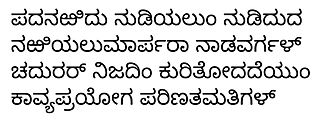
Kavirajamarga is the earliest available work on rhetoric, poetics and grammar in the Kannada language. It was inspired by or written in part by the famous Rashtrakuta King Amoghavarsha I, and some historians claim it is based partly on the Sanskrit text Kavyadarsha. Some historians believe Kavirajamarga may have been co-authored by a poet in the king's court, the Kannada language theorist Sri Vijaya.
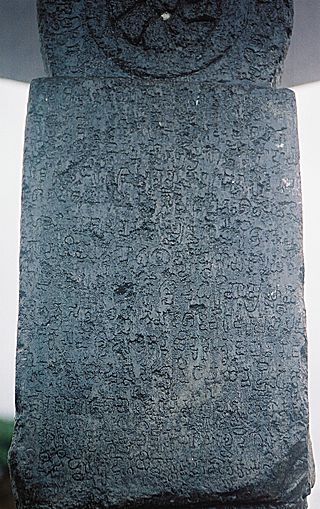
The Halmidi inscription is the oldest known Kannada-language inscription in the Kadamba script. While estimates vary slightly, the inscription is often dated to between 450 CE - 500 CE. The inscription was discovered in 1936 by Dr. M. H. Krishna, the Director of Archaeology of the (princely) State of Mysore, in Halmidi, a village in the Hassan district.
Ponna (c. 945) was a noted Kannada poet in the court of Rashtrakuta Dynasty king Krishna III (r.939–968 CE). The emperor honoured Ponna with the title "emperor among poets" (Kavichakravarthi) for his domination of the Kannada literary circles of the time, and the title "imperial poet of two languages" for his command over Sanskrit as well. Ponna is often considered one among the "three gems of Kannada literature" for ushering it in full panoply. According to the scholar R. Narasimhacharya, Ponna is known to have claimed superiority over all the poets of the time. According to scholars Nilakanta Shastri and E.P. Rice, Ponna belonged to Vengi Vishaya in Kammanadu, Punganur, Andhra Pradesh, but later migrated to Manyakheta, the Rashtrakuta capital, after his conversion to Jainism.
Shivakotiacharya, a writer of the 9th-10th century, is considered the author of didactic Kannada language Jain text Vaddaradhane. A prose narrative written in pre-Old-Kannada, Vaddaradhane is considered the earliest extant work in the prose genre in the Kannada language. Scholars are, however, still divided about when exactly the text was written, with claims ranging from before the 6th century to the 10th century.
The History of Karnataka goes back several millennia. Several great empires and dynasties have ruled over Karnataka and have contributed greatly to the history, culture and development of Karnataka as well as the entire Indian subcontinent. The Chindaka Nagas of central India Gangas, Rashtrakutas of Manyakheta, Chalukyas of Vengi, Yadava Dynasty of Devagiri were all of Kannada origin who later took to encouraging local languages.
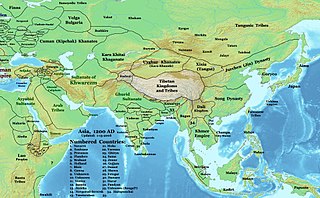
Hoysala literature is the large body of literature in the Kannada and Sanskrit languages produced by the Hoysala Empire (1025–1343) in what is now southern India. The empire was established by Nripa Kama II, came into political prominence during the rule of King Vishnuvardhana (1108–1152), and declined gradually after its defeat by the Khalji dynasty invaders in 1311.
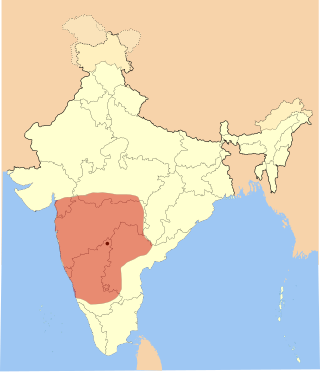
A large body of Western Chalukya literature in the Kannada language was produced during the reign of the Western Chalukya Empire in what is now southern India. This dynasty, which ruled most of the western Deccan in South India, is sometimes called the Kalyani Chalukya Dynasty after its royal capital at Kalyani, and sometimes called the Later Chalukya Dynasty for its theoretical relationship to the 6th-century Chalukya dynasty of Badami. For a brief period (1162–1183), the Kalachuris of Kalyani, a dynasty of kings who had earlier migrated to the Karnataka region from central India and served as vassals for several generations, exploited the growing weakness of their overlords and annexed the Kalyani. Around 1183, the last Chalukya scion, Someshvara IV, overthrew the Kalachuris to regain control of the royal city. But his efforts were in vain, as other prominent Chalukya vassals in the Deccan, the Hoysalas, the Kakatiyas and the Seunas destroyed the remnants of the Chalukya power.
Nāgavarma I (c. 990) was a noted Jain writer and poet in the Kannada language in the late 10th century. His two important works, both of which are extant, are Karnātaka Kādambari, a champu based romance novel and an adaptation of Bana's Sanskrit Kādambari, and Chandōmbudhi, the earliest available work on Kannada prosody which Nāgavarma I claims would command the respect even of poet Kalidasa. According to the scholars K.A. Nilakanta Shastri and R. Narasimhacharya, Nāgavarma I belonged to a migrant Brahmin family originally from Vengi. According to the modern Kannada poet and scholar Govinda Pai, Nāgavarma I lived from 950 CE to 1015 CE. So popular was Nāgavarma I's poetic skills that King Bhoja of Malwa presented him with horses, in appreciation of his poetic skills.
Nagavarma II was a Kannada language scholar and grammarian in the court of the Western Chalukya Empire that ruled from Basavakalyan, in modern Karnataka state, India. He was the earliest among the three most notable and authoritative grammarians of Old-Kannada language. Nagavarma II's reputation stems from his notable contributions to various genres of Kannada literature including prosody, rhetoric, poetics, grammar and vocabulary. According to the scholar R. Narasimhacharya, Nagavarma II is unique in all of ancient Kannada literature, in this aspect. His writings are available and are considered standard authorities for the study of Kannada language and its growth.

Rashtrakuta literature is the body of work created during the rule of the Rastrakutas of Manyakheta, a dynasty that ruled the southern and central parts of the Deccan, India between the 8th and 10th centuries. The period of their rule was an important time in the history of South Indian literature in general and Kannada literature in particular. This era was practically the end of classical Prakrit and Sanskrit writings when a whole wealth of topics were available to be written in Kannada. Some of Kannada's most famous poets graced the courts of the Rashtrakuta kings. Court poets and royalty created eminent works in Kannada and Sanskrit, that spanned such literary forms as prose, poetry, rhetoric, epics and grammar. Famous scholars even wrote on secular subjects such as mathematics. Rashtrakuta inscriptions were also written in expressive and poetic Kannada and Sanskrit, rather than plain documentary prose.
The political history of medieval Karnataka spans the 4th to the 16th centuries, when the empires that evolved in the Karnataka region of India made a lasting impact on the subcontinent. Before this, alien empires held sway over the region, and the nucleus of power was outside modern Karnataka. The medieval era can be broadly divided into several periods: The earliest native kingdoms and imperialism; the successful domination of the Gangetic plains in northern India and rivalry with the empires of Tamilakam over the Vengi region; and the domination of the southern Deccan and consolidation against Muslim invasion. The origins of the rise of the Karnataka region as an independent power date back to the fourth-century birth of the Kadamba Dynasty of Banavasi, the earliest of the native rulers to conduct administration in the native language of Kannada in addition to the official Sanskrit. This is the historical starting point in studying the development of the region as an enduring geopolitical entity and of Kannada as an important regional language.

Western Ganga literature refers to a body of writings created during the rule of the Western Ganga Dynasty, a dynasty that ruled the region historically known as Gangavadi between the 4th and 11th centuries. The period of their rule was an important time in the history of South Indian literature in general and Kannada literature in particular, though many of the writings are deemed extinct. Some of the most famous poets of Kannada language graced the courts of the Ganga kings. Court poets and royalty created eminent works in Kannada language and Sanskrit language that spanned such literary forms as prose, poetry, Hindu epics, Jain Tirthankaras (saints) and elephant management.
Medieval Kannada literature covered a wide range of subjects and genres which can broadly be classified under the Jain, Virashaiva, Vaishnava and secular traditions. These include writings from the 7th century rise of the Badami Chalukya empire to the 16th century, coinciding with the decline of Vijayanagara Empire. The earliest known literary works until about the 12th century CE were mostly authored by the Jainas along with a few works by Virashaivas and Brahmins and hence this period is called the age of Jain literature,. The 13th century CE, to the 15th century CE, saw the emergence of numerous Virashaiva and Brahminical writers with a proportional decline in Jain literary works. Thereafter, Virashaiva and Brahmin writers have dominated the Kannada literary tradition. Some of the earliest metres used by Jain writers prior to 9th century include the chattana, bedande and the melvadu metres, writings in which have not been discovered but are known from references made to them in later centuries. Popular metres from the 9th century onwards when Kannada literature is available are the champu-kavyas or just champu, vachanasangatya, shatpadi, ragale, tripadi, and kavya.
Old Kannada or Halegannada is the Kannada language which transformed from Purvada halegannada or Pre-old Kannada during the reign of the Kadambas of Banavasi.
Harihara was a noted Kannada poet and writer in the 12th century. A native of Halebidu in modern Hassan district, he came from a family of accountants (Karnikas) and initially served in that capacity in the court of Hoysala King Narasimha I. Later, he moved to Hampi and authored many landmark classics. Among his important writings, the Girijakalyana written in champu metre is considered one of the enduring classics of Kannada language.
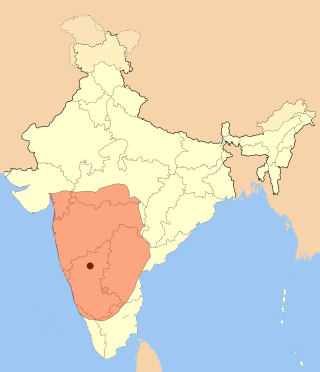
The Chalukya dynasty was a Classical Indian dynasty that ruled large parts of southern and central India between the 6th and the 12th centuries. During this period, they ruled as three related yet individual dynasties. The earliest dynasty, known as the "Badami Chalukyas", ruled from Vatapi from the middle of the 6th century. The Badami Chalukyas began to assert their independence at the decline of the Kadamba kingdom of Banavasi and rapidly rose to prominence during the reign of Pulakeshin II. After the death of Pulakeshin II, the Eastern Chalukyas became an independent kingdom in the eastern Deccan. They ruled from Vengi until about the 11th century. In the western Deccan, the rise of the Rashtrakutas in the middle of the 8th century eclipsed the Chalukyas of Badami before being revived by their descendants, the Western Chalukyas, in the late 10th century. These Western Chalukyas ruled from Kalyani until the end of the 12th century.
References
- Altekar, Anant Sadashiv (1934) [1934]. The Rashtrakutas And Their Times; being a political, administrative, religious, social, economic and literary history of the Deccan during C. 750 A.D. to C. 1000 A.D. Poona: Oriental Book Agency. OCLC 3793499.
- Bhat, Thirumaleshwara (1993) [1993]. Govinda Pai. Sahitya Akademi. ISBN 81-7201-540-2.
- Gai, G. S. (1992). "Studies in Indian History, Epigraphy, and Culture". Karnataka, India: Shrihari Prakashana. Pp. 346.
- Gai, G. S. (1996). Inscriptions of the Early Kadambas (PDF). Indian Council of Historical Research. doi:10.5281/zenodo.573689. ISBN 81-85268-47-9.
- Kamath, Suryanath U. (2001) [1980]. A concise history of Karnataka : from pre-historic times to the present. Bangalore: Jupiter books. LCCN 80905179. OCLC 7796041.
- Karmarkar, A.P. (1947) [1947]. Cultural history of Karnataka : ancient and medieval. Dharwad: Karnataka Vidyavardhaka Sangha. OCLC 8221605.
- Mugaḷi, Raṃ Śrī (2006) [1946]. The Heritage of Karnataka: in relation to India. Read Books [Bangalore: Satyasodhama]. ISBN 978-1-4067-0232-3.
- Nagaraj, D.R. (2003) [2003]. "Critical Tensions in the History of Kannada Literary Culture". In Sheldon I. Pollock (ed.). Literary Cultures in History: Reconstructions from South Asia. Berkeley and London: University of California Press. Pp. 1066. pp. 323–. ISBN 0-520-22821-9.
- Narasimhacharya, R (1988) [1934]. History of Kannada Literature. Mysore: Government Press. Reprinted by Asian Educational Services, New Delhi. ISBN 81-206-0303-6.
- Ramesh, K. V. (1984b), Indian Epigraphy, Sundeep
- Pollock, Sheldon (2003). Literary cultures in history: reconstructions from South Asia. Berkeley: University of California Press. ISBN 0-520-22821-9.
- Pollock, Sheldon (2006). The Language of the Gods in the World of Men: Sanskrit, Culture, and Power in Premodern India (Philip E. Lilienthal Books). Berkeley: University of California Press. ISBN 0-520-24500-8.
- Ramanujan, A.K. (1973). Speaking of Siva . England: Penguin.
- Rice, B.L. (2001) [1897]. Mysore Gazetteer Compiled for Government-vol 1. New Delhi, Madras: Asian Educational Services. ISBN 81-206-0977-8.
- Rice, E.P. (1982) [1921]. A History of Kanarese Literature. New Delhi: Asian Educational Services. ISBN 81-206-0063-0.
- Lewis, Rice (1985). Nagavarmma's Karnataka Bhasha Bhushana. Asian Educational Services. ISBN 81-206-0062-2.
- Salomon, Richard (1998). Indian Epigraphy: A Guide to the Study of Inscriptions in Sanskrit, Prakrit, and Other Indo-Aryan Languages. Oxford and New York: Oxford University Press. Pp. 378. ISBN 0-19-509984-2.
- Sastri, K.A. Nilakanta (2002) [1955]. A history of South India from prehistoric times to the fall of Vijayanagar. New Delhi: Indian Branch, Oxford University Press. ISBN 0-19-560686-8.
- Sircar, D. C. (1996) [1965]. Indian Epigraphy. Delhi: Motilal Banarsidass Publications. ISBN 81-208-1166-6 . Retrieved 29 August 2012.
- Various (1987) [1987]. Encyclopaedia of Indian literature – vol 1. Sahitya Akademi. ISBN 81-260-1803-8.
- Various (1988) [1988]. Encyclopaedia of Indian literature – vol 2. Sahitya Akademi. ISBN 81-260-1194-7.
- Various (1992) [1992]. Encyclopaedia of Indian literature – vol 5. Sahitya Akademi. ISBN 81-260-1221-8.
- Warder, A.K. (1988) [1988]. Indian Kavya Literature. Motilal Banarsidass. ISBN 81-208-0450-3.